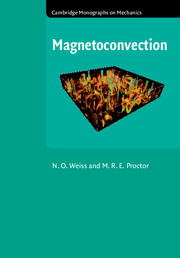Book contents
- Frontmatter
- Dedication
- Contents
- Preface
- 1 Introduction
- 2 Basic MHD
- 3 Linearized Boussinesq magnetoconvection
- 4 The nonlinear regime
- 5 2D Boussinesq magnetoconvection
- 6 3D Boussinesq magnetoconvection
- 7 Magnetoconvection, rotation and the dynamo
- 8 Compressible magnetoconvection
- 9 Solar and stellar magnetic fields
- Appendix A The Boussinesq and anelastic approximations
- Appendix B Chaotic systems
- Appendix C Double-diffusive convection
- Appendix D Magnetic buoyancy and the magneto-Boussinesq approximation
- References
- Index
5 - 2D Boussinesq magnetoconvection
Published online by Cambridge University Press: 05 November 2014
- Frontmatter
- Dedication
- Contents
- Preface
- 1 Introduction
- 2 Basic MHD
- 3 Linearized Boussinesq magnetoconvection
- 4 The nonlinear regime
- 5 2D Boussinesq magnetoconvection
- 6 3D Boussinesq magnetoconvection
- 7 Magnetoconvection, rotation and the dynamo
- 8 Compressible magnetoconvection
- 9 Solar and stellar magnetic fields
- Appendix A The Boussinesq and anelastic approximations
- Appendix B Chaotic systems
- Appendix C Double-diffusive convection
- Appendix D Magnetic buoyancy and the magneto-Boussinesq approximation
- References
- Index
Summary
In this chapter we penetrate further into the nonlinear domain, relying principally on the results of careful numerical experiments, and confining our attention to the simplest and most thoroughly studied configurations. Our primary aim is to extract qualitative understanding from the computations. Once interpreted, they provide a basis for investigating the more complicated structures and patterns that will be treated later in the book.
We begin by extending the mildly nonlinear results in Chapter 4 to cover convection in a rectangular box when the magnetic Reynolds number is large and the magnetic field becomes dynamically important. Then we study the analogous problem in a cylindrical domain with axial symmetry imposed. Next we return to Cartesian models and to the chaotic behaviour that was introduced in Section 4.3, in order to confirm that the Shilnikov effect is present in the full system; in addition, we find a regime with Lorenz-like chaos. Thereafter we consider the effects of relaxing the lateral constraints and thereby allowing travelling waves, together with steady convection in tilted cells and vigorous pulsating waves. That leads us to consider patterns of convection in extended regions, where rolls are modulated at longer wavelengths and localized (or isolated) states can appear. Then we proceed to the strong field limit, and consider behaviour when cells are vertically elongated and very slender. Finally, we discuss the effects of inclined magnetic fields on nonlinear convection.
- Type
- Chapter
- Information
- Magnetoconvection , pp. 113 - 179Publisher: Cambridge University PressPrint publication year: 2014



